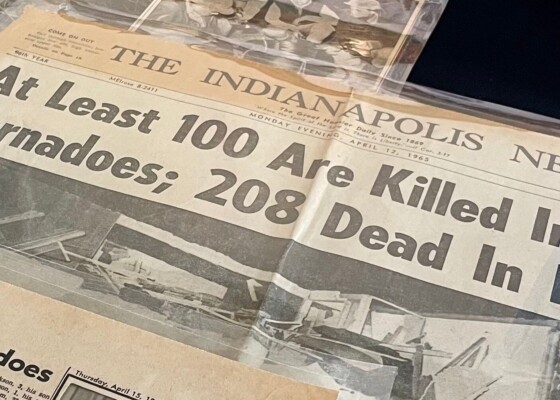Unpacking the Flatness
September 6, 2016“It is flat,” writes Michael Martone. The description that follows this statement is evocative, recognizable to any Hoosier from this stretch of Indiana. But with any vivid description, you can…
“It is flat,” writes Michael Martone. The description that follows this statement is evocative, recognizable to any Hoosier from this stretch of Indiana. But with any vivid description, you can ask, “is this an inner landscape, or an outer one?”
Martone helps us see that such a flatness contains multitudes, in part because every landscape extends across multiple planes–both physical and spiritual. Cultivate meaning across these landscapes, and you begin to understand what the poet Robert Francis meant when he said “my inner world and outer make a pair.”
Outer landscapes are the arena of the senses and the world of objects: the sun in your eyes and on your skin, the flies biting at the back of your neck. Inner landscapes are the arena of memory and internal images. We might imagine that we stock our inner landscape with items from the outer one, but inner landscapes reach forth toward the outer as well.
So what happens when you unpack this flatness, when you cultivate some meaning here? First of all, you note there’s actually gentle roll in the landscape, the work of the “four or five glaciers” Martone mentions. They receded slowly and left behind an inland sea. And now, as Martone explains, this dried seabed is lined with country roads and overpasses, rail tracks, and lakes, ditches, barns.
And tucked away here is Merry Lea: a perfect space to explore all this flatness contains. On the first part of the trail, your skin is cloyed with the mugginess of wetlands. At this stop, you can do as we did: ‘project’ Mary Oliver’s poem “Skunk Cabbage” onto the outer landscape there. Let the poem shape your vision of what you see, and let the landscape shape your vision of the poem.
Then walk along the path some: here you encounter the cooler relief of some denser woods, vernal ponds, and the abandoned ditching system that farmers used to drain the wetland once. The ground continues rolling slightly, in places revealing rich black earth–good for onions apparently. Like us, you can stop to read Todd Davis’s “Kingdom of the Ditch,” which–like the ditches we stood over–reveal the darker ways that humans strive against nature, and how nature even strives against itself.
After the ditches, you arrive at Cub Lake. You can read Mary Linton’s “Making Wild Berry Jam” while you eat some of the blackberries, tasting the berries both by tongue and poem at once. This poem was composed in part at Merry Lea, and there’s something sacramental about the act of tasting both the outer landscape while seeing with the inner.
After that encounter, you’re back in the heat, now dry and full of grassy pollen. The burst of berry fructose is gone, and the sun is more intense now. You’re unshielded, even by the tall grasses. There’s Queen Anne’s Lace here, the same from the ditch and Todd Davis’s poem. Carry these images and insights with you, projecting them outward onto the landscape.
But also don’t stay long because the sun is starting to wear you out, and you have one more stop–along ‘tree avenue,’ to read Roger Pfingston, his “Presence of Trees.” Here, at last, a breeze comes sweeping down the trail to cool you. The dust from the path sticks to your skin. Just stand with the trees and feel their being for a moment. Remember also the trees from your own life which share those names you can read outloud: “oak, / cottonwood and willow / ….white ash.”
Finally you return, ending where you began, more awake to the world around you, and in you.
—————————————————-
Next Indiana Campfires is a unique way to connect nature, literature and Indiana’s Bicentennial. The program is supported by the Efroymson Family Fund, the Nina Mason Pulliam Charitable Trust and Pulitzer Prizes Centennial Campfires. Indiana Humanities is supported in part by Lilly Endowment Inc. and the National Endowment of the Humanities.
This post is part of the weekly blog series devoted to the initiative. This post was written by Micah Towery, professor of english at Goshen College. Towery led our Next Indiana Campfire through Merry Lea Environmental Center in July. Check back every Tuesday to learn more about Indiana’s great environmental literature, find out interesting facts about Hoosier stewardship, get all the latest program details and more.


